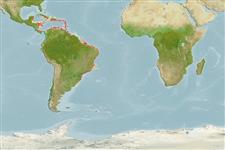Anomalocardia brasiliana (Gmelin, 1791)
West Indian pointed venus| Native range | All suitable habitat | Point map | Year 2050 |

|
| This map was computer-generated and has not yet been reviewed. |
| Anomalocardia brasiliana AquaMaps Data sources: GBIF OBIS |
Classification / Names ชื่อสามัญ | ชื่อพ้อง | CoL | ITIS | WoRMS
Bivalvia | Venerida | Veneridae
Environment: milieu / climate zone / ระดับความลึก / distribution range นิเวศวิทยา
; กร่อย; ระดับความลึก 0 - 5 m (อ้างอิง 83435). Tropical; 21°N - 35°S, 89°W - 34°W
Distribution ประเทศต่างๆ | พื้นที่จำแนกตาม FAO | ระบบนิเวศหลายระบบ | การปรากฏขึ้น,การเกิดขึ้น,พบ | การแนะนำ
Western Atlantic: Caribbean Sea to Brazil, subtropical south America; 16°N to 33°S.
Length at first maturity / ขนาด / Weight / Age
วัยเจริญพันธุ์: Lm ?, range 1 - ? cm Max length : 3.7 cm SHL เพศผู้/กระเทย; (อ้างอิง 130712); อายุสูงสุดที่ได้รายงาน: 3.00 ปี (อ้างอิง 104267)
Life cycle and mating behavior วัยเจริญพันธุ์ | การสืบพันธุ์ | การวางไข่ | Eggs | ความดกของไข่ | Larvae
Main reference
อ้างอิง | ผู้ประสานงาน | ผู้ร่วมมือ
Barreira, C.A.R. and M.L.R. Araújo 2005 Ciclo reprodutivo de Anomalocardia brasiliana (Gmelin, 1791) (Mollusca, Bivalvia, Veneridae) na Praia do Canto da Barra, Fortim, Ceará, Brasil. Boletim do Instituto de Pesca, São Paulo 31(1):9-20. (อ้างอิง 81737)
IUCN Red List Status
(อ้างอิง 130435: Version 2025-1)
CITES status (อ้างอิง 108899)
CMS (อ้างอิง 116361)
Threat to humans
Human uses
การประมง: การค้า
| FishSource |
เครื่องมือ
ข้อมูลเพิ่มเติม
Max. ages / sizes
Length-weight rel.
Length-length rel.
Length-frequencies
Mass conversion
อุดมสมบรูณ์
แหล่งที่มาจากอินเตอร์เน็ต
BHL | BOLD Systems | CISTI | DiscoverLife | FAO(Publication : search) | Fishipedia | GenBank (genome, nucleotide) | GloBI | Gomexsi | Google Books | Google Scholar | Google | PubMed | แผนภูมิชีวิตแบบต้นไม้ | Wikipedia (Go, ค้นหา) | บันทึกทางด้านสัตววิทยา



